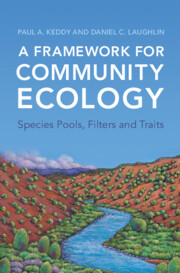19 results
Functional stasis and changing habitat preferences among mammalian communities from the PETM of the Bighorn Basin, Wyoming
-
- Journal:
- Cambridge Prisms: Extinction / Volume 2 / 2024
- Published online by Cambridge University Press:
- 05 December 2024, e20
-
- Article
-
- You have access
- Open access
- HTML
- Export citation
Comparison of methods to detect interspecific competition among parasites in depauperate communities
-
- Journal:
- Journal of Helminthology / Volume 97 / 2023
- Published online by Cambridge University Press:
- 27 December 2023, e105
-
- Article
- Export citation
Microzooplankton community structure in a subtropical South-West Atlantic coastal site
-
- Journal:
- Journal of the Marine Biological Association of the United Kingdom / Volume 103 / 2023
- Published online by Cambridge University Press:
- 06 July 2023, e46
-
- Article
- Export citation

A Framework for Community Ecology
- Species Pools, Filters and Traits
-
- Published online:
- 18 November 2021
- Print publication:
- 09 December 2021
The palm Syagrus coronata proliferates and structures vascular epiphyte assemblages in a human-modified landscape of the Caatinga dry forest
-
- Journal:
- Journal of Tropical Ecology / Volume 36 / Issue 3 / May 2020
- Published online by Cambridge University Press:
- 16 June 2020, pp. 123-132
-
- Article
- Export citation
Species turnover drives the spatial distribution of frog beta diversity in farmland ponds
-
- Journal:
- Journal of Tropical Ecology / Volume 35 / Issue 4 / July 2019
- Published online by Cambridge University Press:
- 23 April 2019, pp. 199-202
-
- Article
- Export citation
Differences among regions in environmental predictors of primate community similarity affect conclusions about community assembly
-
- Journal:
- Journal of Tropical Ecology / Volume 35 / Issue 2 / March 2019
- Published online by Cambridge University Press:
- 25 January 2019, pp. 83-90
-
- Article
- Export citation
Effects of bamboo dominance and palm-heart harvesting on the phylogenetic structure of the seed and seedling communities in an old-growth Atlantic Forest
-
- Journal:
- Journal of Tropical Ecology / Volume 33 / Issue 5 / September 2017
- Published online by Cambridge University Press:
- 26 September 2017, pp. 309-316
-
- Article
- Export citation
Environmental Correlates with Germinable Weed Seedbanks on Organic Farms across Northern New England
-
- Journal:
- Weed Science / Volume 66 / Issue 1 / January 2018
- Published online by Cambridge University Press:
- 24 August 2017, pp. 78-93
-
- Article
- Export citation
Host associations and turnover of haemosporidian parasites in manakins (Aves: Pipridae)
-
- Journal:
- Parasitology / Volume 144 / Issue 7 / June 2017
- Published online by Cambridge University Press:
- 14 March 2017, pp. 984-993
-
- Article
-
- You have access
- HTML
- Export citation
Which Traits Allow Weed Species to Persist in Grass Margin Strips?
-
- Journal:
- Weed Science / Volume 65 / Issue 3 / May 2017
- Published online by Cambridge University Press:
- 14 March 2017, pp. 381-394
-
- Article
- Export citation
The Effect of Rotation and In-Crop Weed Management on the Germinable Weed Seedbank after 10 Years
-
- Journal:
- Weed Science / Volume 59 / Issue 4 / December 2011
- Published online by Cambridge University Press:
- 20 January 2017, pp. 553-561
-
- Article
- Export citation
Restoration Ecology and Invasive Plants in the Semiarid West
-
- Journal:
- Invasive Plant Science and Management / Volume 1 / Issue 4 / October 2008
- Published online by Cambridge University Press:
- 20 January 2017, pp. 399-413
-
- Article
- Export citation
Management Filters and Species Traits: Weed Community Assembly in Long-Term Organic and Conventional Systems
-
- Journal:
- Weed Science / Volume 58 / Issue 3 / September 2010
- Published online by Cambridge University Press:
- 20 January 2017, pp. 265-277
-
- Article
- Export citation
Using Assembly Theory to Explain Changes in a Weed Flora in Response to Agricultural Intensification
-
- Journal:
- Weed Science / Volume 58 / Issue 1 / March 2010
- Published online by Cambridge University Press:
- 20 January 2017, pp. 39-46
-
- Article
- Export citation
Rapid change in the germinable fraction of the weed seed bank in crop rotations
-
- Journal:
- Weed Science / Volume 54 / Issue 6 / December 2006
- Published online by Cambridge University Press:
- 20 January 2017, pp. 1094-1100
-
- Article
- Export citation
Inferring community assembly processes from trait diversity across environmental gradients
-
- Journal:
- Journal of Tropical Ecology / Volume 32 / Issue 4 / July 2016
- Published online by Cambridge University Press:
- 13 June 2016, pp. 290-299
-
- Article
- Export citation
Epiphyte assemblages respond to host life-form independently of variation in microclimate in lower montane cloud forest in Panama
-
- Journal:
- Journal of Tropical Ecology / Volume 30 / Issue 6 / November 2014
- Published online by Cambridge University Press:
- 26 September 2014, pp. 625-628
-
- Article
- Export citation
Rooting depth and above-ground community composition in Kalahari sand woodlands in western Zimbabwe
-
- Journal:
- Journal of Tropical Ecology / Volume 24 / Issue 2 / March 2008
- Published online by Cambridge University Press:
- 01 March 2008, pp. 169-176
-
- Article
- Export citation

